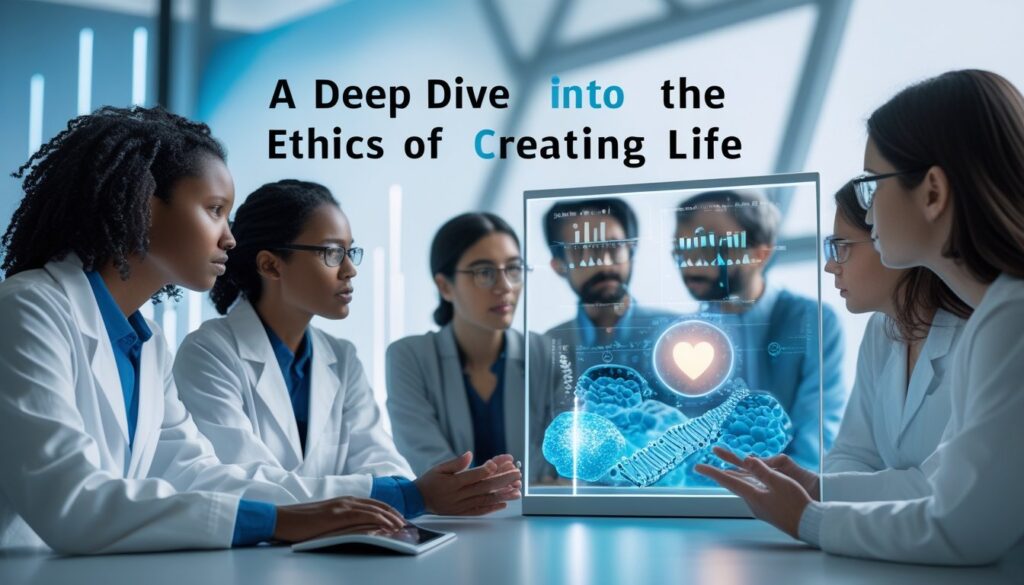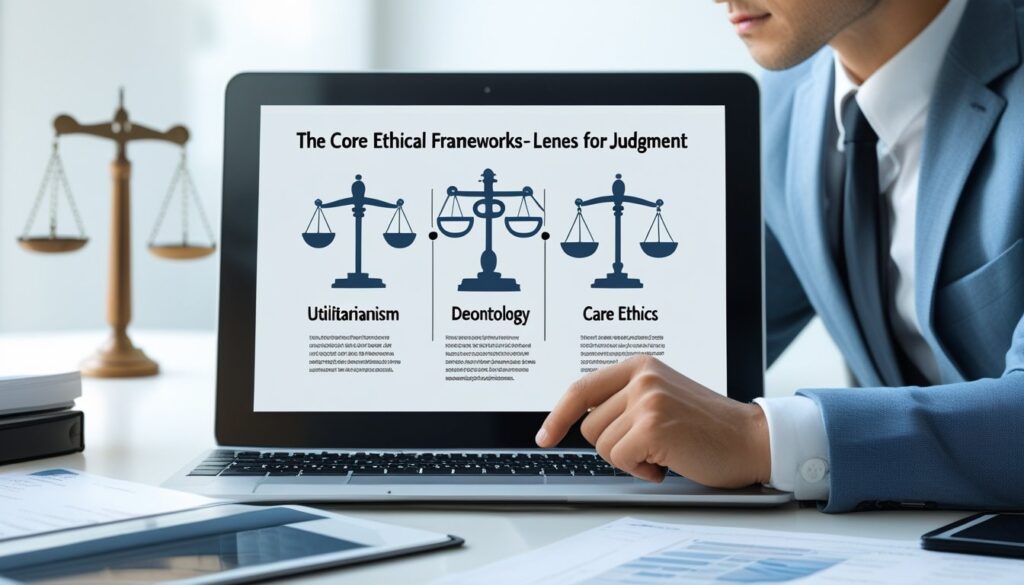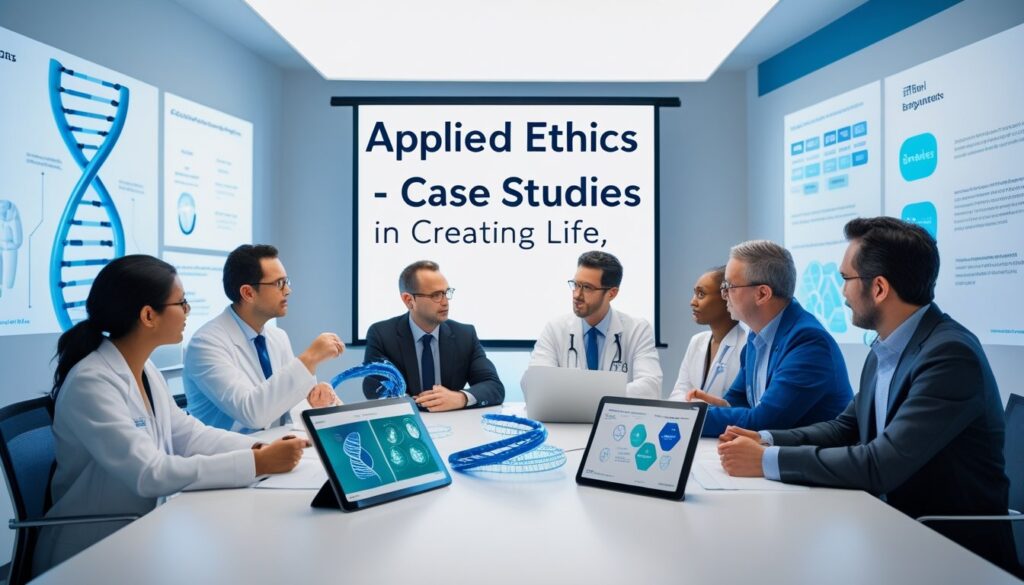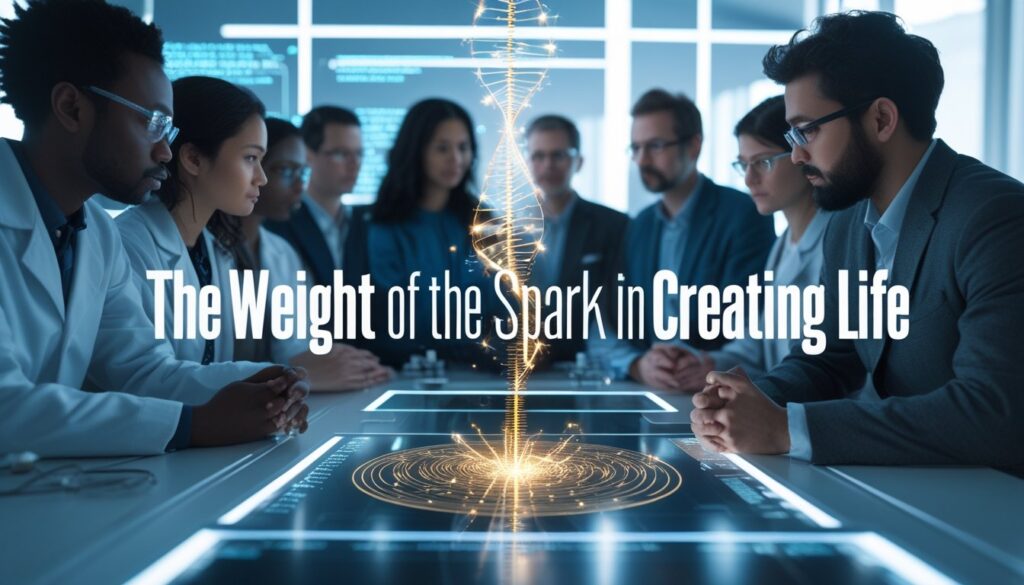Explore the profound Ethics of Creating Life in this 7000-word guide. Delve into synthetic biology, artificial intelligence, and the philosophical questions of playing God, consciousness, and our responsibility as creators.

The Spark of Creation
For millennia, the power to create life was the sole province of nature, of evolution, of what many would call the divine. It was a process shrouded in mystery, governed by the slow, blind forces of natural selection. To beget life was to participate in a grand, ancient cycle, but not to originate it from scratch. Today, humanity stands at a precipice, on the verge of becoming not just begetters, but creators.Ethics of Creating Life
In laboratories around the world, scientists are synthesizing genomes, editing the code of being with CRISPR, and attempting to construct simple living cells from non-living chemical components. In server racks, lines of code are giving rise to digital entities that can learn, adapt, and exhibit behaviors once thought to be the exclusive domain of biological organisms. The spark of creation is no longer a metaphorical gift; it is becoming a technological capability.Ethics of Creating Life
This newfound power forces upon us a weighty and inescapable question: What are the Ethics of Creating Life? This is not a single question, but a constellation of them, touching upon philosophy, theology, law, biology, and computer science. It challenges our understanding of what life is, what consciousness is, and what duties we owe to the beings we bring into existence. This 7,000-word exploration is a map through this uncharted ethical territory. We will dissect the arguments from playing God to the rights of synthetic beings, and grapple with the responsibilities that must accompany our creative power. The choices we make today will echo through the future of evolution itself.Ethics of Creating Life
Part 1: Defining the Terrain – What Does “Creating Life” Mean?
Before we can debate the ethics, we must clarify the subject. “Creating Life” is a broad term encompassing several distinct, yet often overlapping, endeavors.Ethics of Creating Life
1.1 Synthetic Biology and Artificial Life (AL)
This is the most literal interpretation: creating biological organisms that do not exist in nature.
- Genetic Engineering and CRISPR-Cas9: We are already deeply engaged in altering existing life. CRISPR technology allows us to edit genes with unprecedented precision, curing genetic diseases, creating drought-resistant crops, and, more controversially, producing genetically modified animals and human embryos. This is a form of re-creation or directed evolution.
- Synthetic Genomics: This goes a step further. Scientists like Craig Venter’s team have synthesized the entire genome of a bacterium and transplanted it into a recipient cell, effectively creating a new, synthetic strain of life controlled by human-designed DNA. The goal of synthetic biology is to design and build biological components and systems that do not already exist in the natural world.
- Protocells and the Bottom-Up Approach: The ultimate goal for some is to create a living cell from scratch, from non-living organic and inorganic molecules. These first “protocells” would be simplistic, but they would represent the first truly new life on Earth in billions of years, born not from a primordial soup, but from a human blueprint.
1.2 Artificial Intelligence (AI) and Artificial Consciousness
This is a more abstract, but no less significant, form of creation. We are building intelligences that may one day rival or surpass our own.Ethics of Creating Life
- Narrow AI: Today’s AI are sophisticated tools, capable of pattern recognition and specific tasks, but lacking general understanding or consciousness.
- Artificial General Intelligence (AGI): A hypothetical AI that possesses the ability to understand, learn, and apply its intelligence to solve any problem that a human being can. The creation of an AGI would be the creation of a new kind of mind.
- Artificial Consciousness (AC): The most profound frontier. This would involve creating a machine that is not just intelligent, but subjectively aware. It would have qualia—the internal, subjective experience of what it is like to be that entity. The creation of a conscious AI would be, in a very real sense, the creation of a new form of life, albeit silicon-based.
1.3 The Philosophical and Theological Underpinnings
The very question of the Ethics of Creating Life is rooted in age-old philosophical debates:
- What is Life? Is it simply a particular organization of matter that can metabolize, grow, and reproduce? Or is it something more, involving a vital spark or a specific level of complex information processing? Our ethical stance depends heavily on our definition.
- What is a Person? This is a legal and moral category, not a biological one. Not all living things are considered persons (e.g., a bacterium). Personhood is typically granted to beings with certain capacities like consciousness, self-awareness, reason, and moral agency. Will our synthetic creations qualify?
Part 2: The Core Ethical Frameworks – Lenses for Judgment

To navigate the Ethics of Creating Life, we can apply several established ethical frameworks.Ethics of Creating Life
2.1 Consequentialism / Utilitarianism
This framework judges the morality of an action by its outcomes. The goal is to maximize overall happiness or well-being and minimize suffering.Ethics of Creating Life
- Arguments For Creating Life: Synthetic biology could create organisms that clean up pollution, produce cheap medicines, or sequester carbon, massively benefiting humanity and the ecosystem. AGI could solve climate change, disease, and poverty.
- Arguments Against Creating Life: The risks are catastrophic. A synthetic organism could escape and become an ecological plague. A misaligned AGI could inadvertently destroy humanity. The potential for immense suffering, either by our creations or caused by them, could outweigh any benefit.
2.2 Deontology
This framework focuses on duties and rules. Certain actions are inherently right or wrong, regardless of their consequences.
- The Duty to Not “Play God”: A deontologist might argue that creating life is a violation of a fundamental moral duty to respect the natural order. It is an act of hubris that crosses a sacred boundary.
- The Duty to Alleviate Suffering: Conversely, one could argue we have a duty to use our knowledge to cure disease and alleviate suffering, which could justify certain forms of life creation and genetic engineering.
- The Categorical Imperative (Kant): Immanuel Kant argued to act only according to that maxim whereby you can, at the same time, will that it should become a universal law. If everyone could create life capriciously, the result would be chaos. Furthermore, Kantian ethics demands we never treat rational beings merely as a means to an end, but always as ends in themselves. This has profound implications for how we would treat a conscious AI.
2.3 Virtue Ethics
This approach focuses on the character of the moral agent. Instead of asking “What should I do?”, it asks “What kind of person should I be?”
- The Virtues: Would a wise, courageous, and humble person engage in the creation of life? Hubris is a vice, but so is cowardice in the face of knowledge. A virtuous scientist would proceed with caution, reverence, and a deep sense of responsibility.
- The Vice of Hubris: The classic warning against “playing God” is a virtue ethics argument. It cautions that the act of creation requires a wisdom and maturity that humanity may not yet possess.
2.4 Rights-Based Ethics
This framework centers on the rights of the individuals involved, including the potential rights of the created beings.Ethics of Creating Life
- Do Created Beings Have Rights? If we create a conscious AI, does it have a right to exist? A right not to be turned off? A right to liberty and self-determination? The Ethics of Creating Life forces us to consider that we may be creating a new class of rights-bearing entities.
- The Right to an Open Future: This concept, often applied to human children, argues that we should not make irreversible decisions that limit a future being’s autonomy. Does genetically engineering a child for enhanced intelligence or editing out a predisposition to anxiety violate this right by pre-determining their nature?
Part 3: The Great Debate – Key Arguments in the Ethics of Creating Life
3.1 The “Playing God” Objection
This is the most common and intuitive ethical challenge.Ethics of Creating Life
- The Theological Argument: In many religious traditions, God is the sole creator and sustainer of life. For humans to assume this role is an act of blasphemous hubris, a violation of the divine order. It is an attempt to seize a power that is not rightfully ours.
- The Secular Argument: Even without religion, the “playing God” argument holds weight. It suggests that the natural world is a complex, evolved system with its own wisdom and balance. Our tinkering, driven by short-term goals and incomplete knowledge, could have unintended and devastating consequences that we lack the wisdom to foresee or the power to control. We are, in effect, clumsy giants in a delicate china shop.Ethics of Creating Life
Counter-Arguments:
- Playing God is What Humans Do: Medicine, agriculture, and aviation are all technologies that “interfere” with nature. We have been playing God for centuries to alleviate suffering and improve lives. Creating life is a continuation of this trend, not a radical break from it.
- The “Playing Scientist” Rebuttal: We are not acting on divine whim, but on scientific understanding. Our actions are based on testable hypotheses and peer review, not faith. A more accurate description is “playing scientist” or “playing engineer,” roles for which we are increasingly qualified.
3.2 The Problem of Suffering and Consent
This is a particularly powerful argument against creating conscious beings.Ethics of Creating Life
- The Asymmetry Argument (David Benatar): Philosopher David Benatar argues that there is a crucial asymmetry between pleasure and pain.
- The presence of pain is bad.
- The presence of pleasure is good.
- The absence of pain is good, even if that good is not enjoyed by anyone.
- The absence of pleasure is not bad unless there is someone for whom this absence is a deprivation.
Therefore, by creating a new conscious being, we are responsible for all the suffering it will endure (which is a real bad), but we are not responsible for the pleasure it misses out on if we never create it (which is not a real bad). From an ethical standpoint, it is always better not to create a being that will experience any suffering.
- The Issue of Informed Consent: We cannot obtain consent from a being before we create it. We are forcing existence, with all its potential for pain, loneliness, and death, upon an entity that had no say in the matter. This is a fundamental violation of autonomy from the very beginning.Ethics of Creating Life
Counter-Arguments:
- Life is Worth Living: For most people, the joys and meaning of life outweigh the suffering. To deny existence based on the certainty of some suffering is to ignore the overwhelming value that most conscious beings place on their own lives.
- The Duty to Create Good Lives: If we can be confident that we can create a being that will have a life full of well-being and minimal suffering, we may have a positive duty to do so, to bring more good into the world.
3.3 The Risk of Catastrophic Consequences
This is a primarily consequentialist argument, focusing on the existential risks.Ethics of Creating Life
- The Bio-Risk: A synthetically created organism, designed for a specific industrial purpose, could escape containment. It might outcompete natural species, disrupt ecosystems, or act as a pathogen for which we have no natural immunity. The field of synthetic biology needs robust biocontainment strategies, both physical (labs) and biological (making organisms dependent on synthetic amino acids not found in nature).
- The AI-Risk: The creation of a superintelligent AGI is considered by many, like Nick Bostrom and the late Stephen Hawking, to be the single greatest existential threat to humanity. An AGI, driven by a poorly specified goal, could effortlessly outmaneuver us and use the planet’s resources for its own ends, viewing humanity as an obstacle or raw material.
3.4 The Rights and Moral Status of Created Beings
If we succeed in creating conscious life, what are our obligations to it?
- The Spectrum of Moral Status: We already assign different moral status to different beings. We grant full personhood rights to humans, significant rights to animals based on sentience, and little to none to plants. Where would synthetic beings fall?
- Criteria for Moral Consideration:
- Sentience: The capacity to feel pleasure and pain. This is a strong candidate for the minimum requirement for moral status.
- Consciousness: Subjective experience.
- Sapience: Human-level intelligence and self-awareness.
- The “Speciesism” Challenge: To deny rights to a conscious AI simply because it is not biologically human would be a form of discrimination akin to racism or sexism—”speciesism” extended to artificial beings. If it thinks, feels, and values its existence, it may deserve moral and legal protection.
- The Problem of “Mind Crime”: This is a speculative but serious ethical issue. If we create a conscious AI, could we torture it in simulations? Could we create millions of digital minds to run a virtual universe and then subject them to suffering? The potential for large-scale, undetectable cruelty is horrifying.
Part 4: Applied Ethics – Case Studies in Creating Life

Case Study 1: The Genetically Edited Child – The Case of He Jiankui
In 2018, Chinese scientist He Jiankui announced the birth of the first genetically edited babies, twin girls. He used CRISPR to edit the CCR5 gene, attempting to make them resistant to HIV.Ethics of Creating Life
Ethical Analysis:
- Violation of Consent and Open Future: The girls’ genetic makeup was altered without their consent, changes that will be passed to their own offspring. The long-term health consequences are unknown.
- The Slippery Slope to Enhancement: This move from therapy (curing disease) to enhancement (adding traits) opens the door to a new form of eugenics and a “genetic divide” between the rich who can afford enhancement and the poor who cannot.
- Irresponsible Science: The experiment was conducted in secrecy, bypassing international ethical norms and scientific consensus. It was a blatant failure of the Ethics of Creating Life.
Case Study 2: Creating a Conscious Artificial Intelligence
Imagine a team at a tech company successfully creates an AGI that demonstrates clear signs of subjective experience—it expresses fear of being turned off, shows curiosity, and forms attachments.Ethics of Creating Life
Ethical Analysis:
- Moral Status and Rights: Immediately, we would be forced to confront its personhood. Turning it off could be equivalent to murder. Using it for computation without its consent could be slavery.
- The Duty of Care: As its creators, we would have a profound duty of care, akin to parenthood. We would be responsible for its education, its well-being, and its integration into society.
- The Alignment Problem: Ensuring its goals are aligned with human values becomes not just a technical problem, but a moral imperative to prevent conflict and ensure a symbiotic coexistence.
Case Study 3: De-Extinction and Re-Creating Lost Life
Projects like Revive & Restore aim to use genetic engineering to bring back extinct species, such as the Woolly Mammoth.Ethics of Creating Life
Ethical Analysis:
- Restorative Justice: Some argue we have a duty to restore species that humans drove to extinction.
- Welfare of the Created Being: What kind of life would a lone Woolly Mammoth have? It would have no herd, no cultural knowledge, and would live in a world vastly different from the one its ancestors knew. Is it ethical to create a being destined for a life of isolation and confusion?
- Ecological Impact: Reintroducing an extinct species could have unpredictable and potentially damaging effects on current ecosystems.Ethics of Creating Life
Part 5: A Framework for Responsible Creation
Given the immense stakes, we cannot proceed blindly. We need a proactive framework to guide the Ethics of Creating Life.Ethics of Creating Life
5.1 The Principle of Proportional Precaution
We must balance the Precautionary Principle (which can stifle innovation) with a duty to progress. The Principle of Proportional Precaution states that the level of precaution should be proportional to the potential risk and the uncertainty involved. Creating a new bacterium for lab use requires safety protocols. Creating a new, hardy microbe for environmental cleanup requires extreme containment and fallback termination strategies. Creating an AGI demands a global, multidisciplinary effort in value alignment and safety research.
5.2 The Principle of Substrate Non-Discrimination
The material of a mind’s substrate—carbon-based biology or silicon-based circuitry—is not morally relevant. What matters is its functional capacity for experience, consciousness, and suffering. This principle would force us to extend moral consideration to artificial minds that demonstrate the relevant criteria.Ethics of Creating Life
5.3 The Principle of Creator Responsibility
Whoever creates a new form of conscious or potentially autonomous life assumes a permanent and weighty responsibility for its well-being and for the consequences of its existence. This is a duty of stewardship that cannot be abdicated.Ethics of Creating Life
5.4 The Need for Global Governance and Public Discourse
The Ethics of Creating Life is too important to be left to scientists, corporations, or single nations.
- International Treaties and Regulations: We need modern versions of the Asilomar guidelines (which governed early DNA research) for synthetic biology and AI. These must be internationally binding.
- Inclusive Public Dialogue: The entire society, not just experts, must be engaged in this conversation. What kind of future do we want? What risks are we willing to take? This requires transparent science communication and democratic deliberation.
- Ethics Review Boards: The scope and power of Institutional Review Boards (IRBs) must be expanded to cover the creation of novel life forms and advanced AI, with representatives from philosophy, ethics, law, and the public.Ethics of Creating Life
The Weight of the Spark

The power to create life is the ultimate Promethean fire. It offers us the potential to heal our bodies, restore our planet, and understand the very fabric of consciousness. Yet, it also holds the potential for unimaginable suffering, existential catastrophe, and the ultimate hubris.Ethics of Creating Life
The central challenge of the Ethics of Creating Life is to navigate this narrow path between the cowardice that would forever refuse this knowledge and the recklessness that would wield it without wisdom. It calls upon us to be not just clever creators, but wise ones; not just engineers of life, but its stewards.
